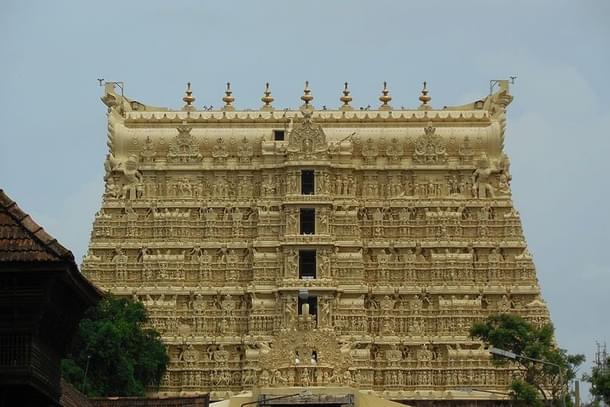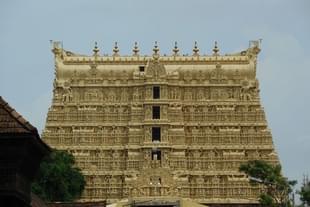Politics
Sree Padmanabhaswamy Temple Verdict Is A Huge Victory For Hindus; Let No One Tell You Otherwise
Arihant Pawariya
Jul 17, 2020, 06:28 PM | Updated Jul 18, 2020, 08:06 AM IST
Save & read from anywhere!
Bookmark stories for easy access on any device or the Swarajya app.


The Hindu side is not used to winning legal battles in courts.
One can either blame it on the decay in judiciary which set in after Indira Gandhi’s constant meddling and packing of courts with her or Congress sympathisers. Or the blame can be laid at the feet of the misplaced notions of secularism internalised by ideologically Left-leaning judges who saw red in everything saffron.
Whatever the ill one may point fingers at, the bottom line is that Lady Justice has frustrated the Hindu community for far too long. And this has caused millions to lose faith and trust in our esteemed black robes.
But thanks to the recent landmark judgement in the Ram Janmabhoomi case, some are willing to give judiciary a chance again. But there are obviously many Hindus out there who will continue to second guess its decisions, thanks to the mistrust. It’s understandable even though it’s not right.
This is what seems to have happened in the Padmanabhaswamy temple case where the Supreme Court delivered a big victory to the Hindu side on 13 July but still received brickbats because the judgement wasn’t perfect and had some minor flaws.
Swarajya’s editorial director R Jagannathan wrote a scathing piece on the Supreme Court verdict terming it “a cruel joke”. He highlighted two reasons for his critique of the judgement.
One, the temple and not the state will now have to bear the expenses for providing security of the premises which houses treasures worth thousands of crores.
Two, the audit ordered by the court going back 25 years is unprecedented and may become a tool for harassment.
Others who have criticised the judgement are apprehensive that it paves an indirect way for the government’s intervention in the temple’s affairs by issuing directives to set up advisory and administrative committees, whose majority members will be government representatives.
Let us address this very concern before I explain why this verdict must be treated as a big victory.
Two models were presented before the court regarding the management of the temple. The royal family, the appellants, in their submission had recommended that two committees be formed, namely advisory and administrative.
The state, the respondent, suggested that the model be based on the Guruvayoor Devaswom Board with an eight-member managing committee comprising of two ex-officio members — Padmanabhadasa and the senior thantri while the other six members be ministers in state government, nominated by Hindus.
The model picked by the Supreme Court, and which is receiving so much criticism, was actually the one suggested by the Travancore Royal Family itself with one change. The appellants had suggested that the administrative committee be led by a retired IAS officer but the court has ordered that it will be chaired by the district judge of Thiruvananthapuram instead.
Not only that, the Supreme Court has asked the parties to “ensure that all rituals and religious practices are performed in accordance with the instructions and guidance of the Chief Thantri of the temple and according to custom and traditions”.
Not just that, the Supreme Court further rules that even “in temporal matters, the Committees shall be guided by the advice given by the Chief Thantri.”
That means that for all practical purposes, religious or temporal, the control has been vested in hands of the chief thantri.
What more can the devotees of the temple ask for?
Now, let’s turn to explaining why this is a comprehensive victory for the Hindu side.
There were five key questions before the court.
First, how integral and unique the relationship between Travancore royal family and the temple is, right from the establishment of the temple.
After going through every account of history of the temple and the family presented to it, the court declared that:
The King of Travancore was thus responsible for setting up the Temple, in the form that it stands today, and it was the King who installed the new idol, and since then the management of the Temple, till the Covenant was signed, had always been with the Kings of Travancore.
More importantly, it concluded:
We must thus conclude that as on the day when the Covenant was entered into by the Ruler of the Covenanting State of Travancore, apart from other incidents which normally follow the rulership, he was holding the office of Shebait of the Temple and represented a continuous and unbroken line of successive Shebaits traced from the original founder; and being a Shebait of the Temple, he was having all the rights and interest as laid down by decisions referred to hereinabove.
Hindu side 1, state of Kerala 0
Now that it was proven that the then ruler of the Travancore, who had signed the covenant in 1949, was indeed the rightful Shebait, the next question was whether he gave up that right by signing the covenant and merging his state with the Indian Union.
Second, what was the effect of entering into covenant in May 1949?
Was the office of Shebaitship of the temple part of the duties of the ruler purely in his capacity as a ruler or was it totally unconnected to and independent of the rulership?
Citing Article VIII of the Covenant, the apex court ruled:
...the historical background and the association of the royal family with the Temple and the nature of Shebaitship held by a successive line of Rulers from time to time, were such that the Covenant designedly let the management of the affairs of the Temple – with the royal family, and in the hands of the Ruler of Travancore, principally because his official capacity or status as the erstwhile Head of the State apparently had nothing to do with the capacity as Shebait of the Temple.
So, the court accepted that the Shebaitship of the temple didn’t flow from the fact of being the ruler of the state. It was independent of such a title.
Hindu side 2, state of Kerala 0
Third, did the Constitution of India and further the Travancore-Cochin Hindu Religious Institutions Act of 1950 (TC Act) alter the status and entitlement of the ruler of Travancore to the Shebaitship of the temple?
To this, the court said:
...the relevant provisions of the Constitution of India as well as that of the TC Act did not, in any way, upset or abridge the status enjoyed by the Ruler of Travancore as Shebait of the Temple and also did not, in any manner, adversely impact the right of administration vested in the Ruler of Travancore. As a matter of fact, the relevant provisions of the TC Act afforded statutory flavour to the status contemplated by Article VIII of the Covenant.
Hindu side 3, state of Kerala 0
Fourth, did the 26th constitutional amendment act which abolished privy purses and other privileges of former kings affect the status and entitlement of the ruler of Travancore to the Shebaitship of the temple?
Answering this, the court ruled that it
...did not in any way impact or affect the administration of the Temple, Sri Pandaravaga properties and the properties of the Temple, which continued to be under the control and supervision of the Ruler of Travancore.
Hindu side 4, state of Kerala 0
The fifth question for deciding before the court was whether the death in 1991 of Sree Chithira Thirunal Balarama Varma who had signed the Covenant, affect the Shebaitship of the temple held by the royal family of Travancore?
Resolving this, the court categorically stated in the negative and further held that:
After such death, the Shebaitship must devolve in accordance with the applicable law and custom upon his successor; that the expression “Ruler of Travancore” as appearing in Chapter III of Part I of the TC Act must include his natural successors according to law and custom; and that the Shebaitship did not lapse in favour of the State by principle of escheat.
Hindu side 5, state of Kerala 0
On top of that, the court has said that the committees will be guided by the chief thantri giving him complete control (both in religious and temporal matters) as I explained earlier in the article.
So, where is the matter of discouragement that so many Hindus are wallowing in?
Yes, had the court accepted lawyer J Sai Deepak’s submissions regarding Article 25 and Article 26 which called for a) bestowing the fundamental rights enshrined in the Constitution on Hindu deities and b) giving denominational status to the temple, then for thousands of temples it would have paved the path for movement for freedom in the country. But, the court didn’t entertain this important aspect (not entertaining shouldn’t be confused with rejecting here).
So, in a way, while this is a great judgement for the temple and has limited implications for other temples who are in same situation (in Mysore, Kashi, Rajasthan, etc), the verdict is not a panacea for the “freeing temples from government control’ movement.
But let’s not miss forest for the trees. Nonetheless, it’s a great and comprehensive victory. And Hindus need to cherish it.
Arihant Pawariya is Senior Editor, Swarajya.





